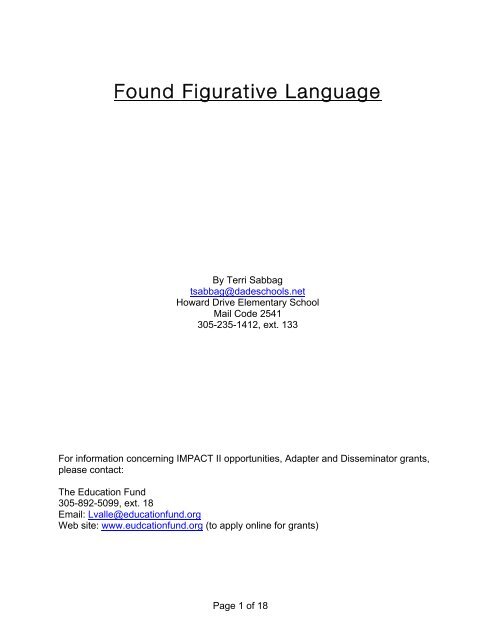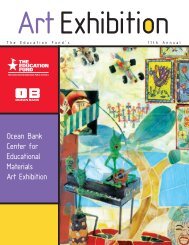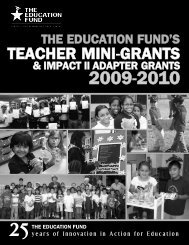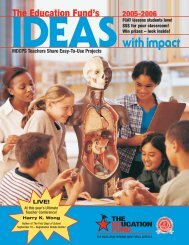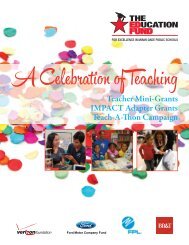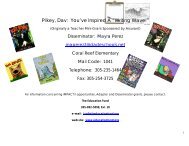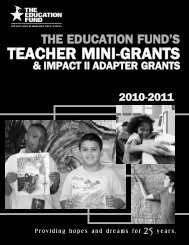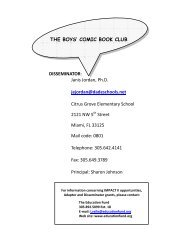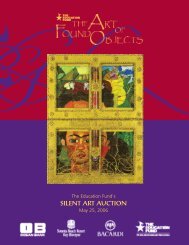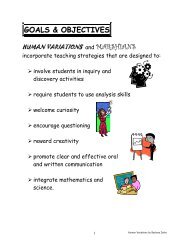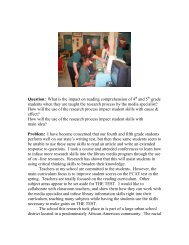Found Figurative Language by Terri Sabbag - The Education Fund
Found Figurative Language by Terri Sabbag - The Education Fund
Found Figurative Language by Terri Sabbag - The Education Fund
Create successful ePaper yourself
Turn your PDF publications into a flip-book with our unique Google optimized e-Paper software.
<strong>Found</strong> <strong>Figurative</strong> <strong>Language</strong><br />
By <strong>Terri</strong> <strong>Sabbag</strong><br />
tsabbag@dadeschools.net<br />
Howard Drive Elementary School<br />
Mail Code 2541<br />
305-235-1412, ext. 133<br />
For information concerning IMPACT II opportunities, Adapter and Disseminator grants,<br />
please contact:<br />
<strong>The</strong> <strong>Education</strong> <strong>Fund</strong><br />
305-892-5099, ext. 18<br />
Email: Lvalle@educationfund.org<br />
Web site: www.eudcationfund.org (to apply online for grants)<br />
Page 1 of 18
Table of Contents<br />
Goals and Objectives ..................................................................................................... 3<br />
Course Outline/Overview ............................................................................................... 4<br />
Lesson Plans .................................................................................................................. 5<br />
Resource List ................................................................................................................ 10<br />
Teacher-made Resources…………..……………………………………………………....12<br />
Photographs…………………………………………………………………….…………….16<br />
Adapter Application ..................................................................................................... 18<br />
Page 2 of 18
Goals and Objectives<br />
<strong>The</strong> following Next Generation Sunshine State Standards are applicable to this course.<br />
Strand: Reading Application<br />
Benchmark: LA.4.1.7.2 <strong>The</strong> student will identify the author’s purpose (e.g. to persuade,<br />
inform, entertain, explain) and how an author’s perspective influences text.<br />
Strand: Literary Analysis<br />
Benchmark: LA.4.2.1.7 <strong>The</strong> student will identify and explain an author’s use of<br />
descriptive, idiomatic, and figurative language (e.g. personification, similes, metaphors,<br />
symbolism) and examine how it is used to describe people, feelings, and objects.<br />
Strand: Writing Process<br />
Benchmark: LA.4.3.3.3.3 Creating precision and interest <strong>by</strong> expressing vividly through<br />
varied language techniques (e.g. imagery, simile, metaphor, sensory language)<br />
Page 3 of 18
Course Overview<br />
<strong>Figurative</strong> language helps to create imaginative and detailed writing. <strong>The</strong>re can never<br />
be too many examples of figurative language, particularly when one is a fourth grade<br />
teacher instructing children on identifying figurative language, and then creating and<br />
incorporating it in their own writing.<br />
I began the figurative language unit with my fourth grade class <strong>by</strong> familiarizing students<br />
with the different facets of figurative language. I have various posters and charts that I<br />
have made and have bought with definitions and examples of figurative language<br />
hanging on the walls in my classroom. From the first day, I encouraged the students to<br />
find examples of personification in their independent reading. Subsequently, they<br />
searched for similes, metaphors, hyperbole, and onomatopoeia. As we read poetry,<br />
trade books, and non-fiction books and articles, I pointed out various examples. I then<br />
distributed Post-it notes for students to mark the pages in their books each time they<br />
found figurative language. We shared their findings aloud with the class on a daily<br />
basis.<br />
Once students started hunting for similes, metaphors, personification, etc. on their own,<br />
they were soon “flooding” me each morning with examples. <strong>Figurative</strong> language<br />
appeared all day long, in all aspects of their reading. With so many examples pouring<br />
in, I decided they should be displayed; so, I provided students with index cards for them<br />
to record their examples, which I subsequently tacked on a bulletin board.<br />
One morning, two of my students handed me a large stack of index cards. I remarked<br />
that they were quickly developing into the “queens” of figurative language and that we<br />
needed a crown. Immediately, one of the girls volunteered to make one, and the very<br />
next day, a plastic, jeweled tiara arrived. <strong>The</strong> students and I then decided that the boy<br />
who provided the most figurative language would be crowned “king” and that he should<br />
carry a scepter. Again, an eager student volunteered his artist-mother to create a staff.<br />
Queen FL (figurative language) and King Scribe were born. We then decorated an old<br />
jewelry box where students could place their figurative language “treasures,” which<br />
were read aloud daily and displayed.<br />
My fourth grade students nominated the King and Queen, based on either the number<br />
of examples the students turned in or the richest examples found.<br />
Displaying student examples on a bulletin board provided: (1) a daily incentive for<br />
students to find their own FL for display; (2) an opportunity to be exposed to a plethora<br />
of figurative language examples: and (3) opportunities to get recommendations from<br />
peers for books rich in figurative language.<br />
<strong>The</strong> students took great delight in this incentive to find writing treasures and to share<br />
them with the class. Each Queen FL and King Scribe proudly wore/carried their royal<br />
finery on the day they were crowned<br />
Page 4 of 18
Lesson Plans<br />
Objectives:<br />
Strand: Reading Application<br />
Benchmark: LA.4.1.7.2 <strong>The</strong> student will identify the author’s purpose (e.g. to<br />
persuade, inform, entertain, explain) and how an author’s perspective influences<br />
text.<br />
Strand: Literary Analysis<br />
Benchmark: LA.4.2.1.7 <strong>The</strong> student will identify and explain an author’s use of<br />
descriptive, idiomatic, and figurative language (e.g. personification, similes,<br />
metaphors, symbolism) and examine how it is used to describe people, feelings, and<br />
objects.<br />
Strand: Writing Process<br />
Benchmark: LA.4.3.3.3.3 Creating precision and interest <strong>by</strong> expressing vividly<br />
through varied language techniques (e.g. imagery, simile, metaphor, sensory<br />
language)<br />
Personification Lesson Plan:<br />
Activity:<br />
1. Teacher sits on top of the desk and then asks students: “How do you think the<br />
desk is feeling with me sitting on top of him?”<br />
2. Allow various responses (e.g., complains because of the weight, moans under<br />
the weight, creaks under the weight, etc.)<br />
3. Instruct students to create sentences describing the action of the teacher sitting<br />
on the desk and the reaction the desk experiences with the teacher sitting on<br />
top. (e.g., As Ms. <strong>Sabbag</strong>’s feet kicked back and forth, the desk struggled and<br />
moaned under her weight, wishing she would get off.)<br />
4. Define personification as “giving human qualities to an object, thing, or animal.”<br />
5. Have students form small groups to discuss how a pencil feels as a student takes<br />
a timed multiplication test.<br />
6. Instruct the groups to first make a list of the pencil’s feelings.<br />
Page 5 of 18
7. Encourage students to associate body parts with the pencil. For example: <strong>The</strong><br />
pencil screeched in pain as the student turned him on his head and feverishly<br />
erased the 7 from the paper.<br />
8. Working in their groups, the student are to create sentences, showing how the<br />
pencil feels during the test.<br />
Evaluation: Check students’ personification sentences; star any sentences that are<br />
especially creative to be shared the next day with the whole group.<br />
Home Learning:<br />
1. Students will choose an object found in their kitchens at home and personify it.<br />
<strong>The</strong>y will create a feelings and parts list, and then create sentences using<br />
personification.<br />
2. Instruct students to search for personification in their independent reading. <strong>The</strong>y<br />
should mark the page with a Post-it note, without interrupting the flow of their<br />
reading. <strong>The</strong>y can later go back and write the personification sentence on the<br />
Post-it note and leave it on the page where it was found. <strong>The</strong>y should be<br />
prepared to share examples with the class.<br />
Adapt Personification Lesson Plan to Teach Similes:<br />
Activity:<br />
1. Sit on top of the desk. Remind students of their previous discussion in class<br />
when they “personified” the desk as the teacher was sitting on top of it (e.g.,<br />
moaning under the weight, creaking under the weight, etc.).<br />
2. Ask students: “Can we compare the creak of the desk to something else?<br />
(e.g., creaks like a rusty hinge)<br />
3. Create sentences, orally, with the students, comparing the moans and creaks to<br />
similar objects. (e.g.; Straining under the weight of the teacher as she sat<br />
teaching her class, the desk creaked and whined like a rusty hinge.)<br />
4. Define simile as a specific comparison between two different things. <strong>The</strong><br />
comparison is made <strong>by</strong> using ‘like’ or ‘as’.<br />
5. Provide examples of similes. Discuss what is being compared and what aspect<br />
of is being compared. (see resource list)<br />
ex. <strong>The</strong> clouds are like cottonballs in the sky.<br />
Page 6 of 18
What is being compared? Students may say that clouds and cotton balls are<br />
being compared. I require more precise details than that. What aspects of the<br />
clouds are being compared? <strong>The</strong>ir shape, color, texture?<br />
6. Have students form their small groups from the previous lesson to use the<br />
“pencil” personifications that they created.. Students are to discuss other things<br />
they can use to compare the way the pencil feels, sounds, looks, etc. during the<br />
timed multiplication test.<br />
7. Encourage students to associate body parts with the pencil as they create<br />
similes. (For example: <strong>The</strong> pencil point was a sharp as a pin, ready to conquer<br />
the math test.)<br />
Evaluation: Check students’ similes; star any sentences that are especially creative to<br />
be shared the next day with the whole group.<br />
Home Learning:<br />
1. Students will choose a weather phenomenon and create 2 similes comparing its<br />
appearance, force, effects, etc.<br />
2. Instruct students to search for similes in their independent reading. <strong>The</strong>y should<br />
mark the page with a Post-it note, without interrupting the flow of their reading.<br />
<strong>The</strong>y can later go back and write the simile sentence on the Post-it note and<br />
leave it on the page where it was found. <strong>The</strong>y should be prepared to share<br />
examples with the class.<br />
Adapt Simile Lesson Plan to Teach Metaphors:<br />
Activity:<br />
1. Explain that metaphors are similar to similes because they compare two things.<br />
However, metaphors are more potent than similes because they state that one<br />
thing ‘is’ another thing; like and as are not used in the comparison.<br />
2. Provide examples of metaphors (e.g., grass is nature’s blanket) and discuss the<br />
things being compared. Metaphors are not as easy to identify as similes. It is<br />
helpful to identify the aspect that is being compared. (e.g., size, shape, feeling,<br />
sound, etc.)<br />
3. Using the similes created in the previous pencil lesson, work with the students to<br />
adapt the similes <strong>by</strong> taking out the ‘like’ or ‘as’ to create metaphors. (e.g., <strong>The</strong><br />
pinpoint pencil tip stood at attention, ready to conquer the math test.)<br />
Page 7 of 18
4. Have students work in small groups to create metaphors using their weather<br />
similes from the home learning activity from the previous lesson.<br />
5. Groups will share their metaphors with the class.<br />
Evaluation: Check students’ metaphors.<br />
Home Learning:<br />
1. Students will look at the clouds and create 2 metaphors describing the cloud’s<br />
shape, appearance, obstacles, etc.<br />
2. Instruct students to search for metaphors in their independent reading. <strong>The</strong>y<br />
should mark the page with a Post-it note, without interrupting the flow of their<br />
reading. <strong>The</strong>y can later go back and write the metaphor sentence on the Post-it<br />
note and leave it on the page where it was found. <strong>The</strong>y should be prepared to<br />
share examples with the class.<br />
Other <strong>Figurative</strong> <strong>Language</strong><br />
Discuss and give examples of other forms of figurative language:<br />
• Hyperbole: an overstatement or exaggeration used to express an idea (e.g., I<br />
was hungry enough to eat a herd of elephants! – or - I have told you a thousand<br />
times not to play with matches.)<br />
• Onomatopoeia: using words such as buzz or thud that sound like the sound<br />
they refer to.<br />
Queen FL and King Scribe Lesson Plan:<br />
Now that students are familiar with the different forms of figurative language, they<br />
should continue using Post-it notes to mark pages in their independent reading where<br />
they find examples.<br />
Materials:<br />
• index cards<br />
• shoebox decorated to look like a treasure chest<br />
• bulletin board with figurative language headings: personifications – similes –<br />
metaphors – hyperbole – onomatopoeia<br />
Page 8 of 18
Book Title: ____________<br />
Author’s name: __________<br />
Quoted sentence(s) from the book:<br />
Activity:<br />
1. Take one student’s book with the Post-it note marking the figurative language<br />
example. .<br />
Type of <strong>Figurative</strong> <strong>Language</strong> (simile, metaphor, etc.)<br />
2. Model how to record the student’s example on an index card as shown below:<br />
Student Name:<br />
3. Post the student’s index card example under the proper heading on the bulletin<br />
board.<br />
4. Show students the treasure box and inform them that the index cards should be<br />
placed in the box; the teacher will retrieve them from the box and read them<br />
daily.<br />
5. Distribute index cards to students to record the example(s) they brought in from<br />
their independent reading. Explain that from now on, creating the index cards<br />
will be done independently. A Queen FL and King Scribe will be nominated daily<br />
or weekly, based on criteria established <strong>by</strong> the teacher.<br />
Evaluation: Check index cards for accuracy before posting.<br />
Page 9 of 18
Resource List<br />
Books:<br />
Bennett, G. Molloy, P., Cavalcade of Poems, Scholastic, 1968.<br />
Bennett-Hopkins, L. Arenstein, M., Potato Chips and a Slice of Moon, Scholastic. 1976.<br />
Bennett-Hopkins, l., Pterodactyls and Pizza, Trumpet Club, 1992.<br />
Dunning, S., Lueders, E., Smith, H., Reflections on a Gift of Watermelon Pickles,<br />
Scholastic, 1986.<br />
Literature and Writing Workshop: Exploring Lyric Poetry, Scholastic, 1993.<br />
McGovern, A., Arrow Book of Poetry, Scholastic, 1965.<br />
Sears, P., Gonna Bake me a Rainbow Poem: A Student Guide to Writing Poetry,<br />
Scholastic, 1990.<br />
Stine, R. L., Goosebumps: Vampire Breath, Scholastic 1996. (pp. 4, 13)<br />
Sweeney, J., Teaching Poetry, Yes You Can!, Scholastic, 1993.<br />
Tucker, S., Painting the Sky, Good Year Books, 1995.<br />
Resources:<br />
• (2) Poetry Anthology: Poem selections, checklist, and figurative language definitions<br />
• (2) <strong>Figurative</strong> <strong>Language</strong> Chart: Record examples of found figurative language<br />
Websites:<br />
Discovery <strong>Education</strong> United Streaming<br />
• A Closer Look at <strong>Figurative</strong> <strong>Language</strong>: Discovering <strong>Language</strong> Arts: Grades 03-<br />
05: Style, Structure, and Tone<br />
Page 10 of 18
• Simile and Hyperbole: Discovering <strong>Language</strong> Arts: Grades 03-05: Fiction<br />
• Similes and Idioms: In a Manner of Speaking Discovering <strong>Language</strong> Arts:<br />
Grades 03-05: Listening and Speaking<br />
www.brainpop.com<br />
• English<br />
o Writing<br />
o Similes and Metaphors<br />
o Poetry<br />
Page 11 of 18
Teacher-made Resources<br />
Page 12 of 18
Page 13 of 18
Page 14 of 18
Page 15 of 18
Page 16 of 18
Page 17 of 18
Page 18 of 18


